
Last year there were almost no salads in our garden. So we have extended the list for this season.
If you keep such a table year after year, it helps to develop a good routine. We can keep track of what we have planted and in what quantities, and after the season we can evaluate what we want to optimise next year. Of course the list is based on our preferences and garden size. It is our personal seed plan. Nevertheless, we would like to share the table with you, as our approach, cultivation quantities and certainly also our choice of varieties could be exciting for one or the other.
In 2018, we have just really started growing vegetables and are currently testing ourselves through different varieties to discover which we like best, but also which are well suited to our location. This is one of the reasons why we cultivate so many different varieties. We love the variety of shapes, colours and flavours and use different varieties of one species in the kitchen for very different preparations. Whether, for example, our tomatoes are freshly picked and served on bread, boiled down to make tomato sauce or dried is determined by the size, consistency and, of course, aroma of the fruit.
Our seeds are organically grown and seedfast. This enables us to obtain the seeds ourselves for certain crops. Over time, our own seed adapts itself better and better to our location and thus thrives as well as possible under the conditions prevailing here. At present, we only harvest seed from a few crops, but we would like to expand our own seed production in the coming years. Here we have to learn something new again! So it never gets boring while gardening.
The new year is just two weeks old and already we are back in garden fever and oscillate between seed bags, tables and notes from last season.
If you, like us, grow more than 100 different varieties of vegetables, you need a little planning, especially at the beginning, in order not to lose the overview. Therefore we have created a table with which we work throughout the year.
In addition to the varieties, we note here the approximate amount of plants that we would like to grow in that year and advice on how often we should replant the crop to achieve the longest possible harvest period. In the table we find information about whether and when to germinate seeds indoors (orange colored), when they can be planted out or sown outdoors (green colored). Whether the crops should be planted outdoors or in the greenhouse and with what plant spacing. Whether they are heavy, medium or light feeders and where we have obtained the seeds from in order to buy them later if necessary. A small database that helps us to plan our garden year.
Thanks to calendar columns we can work through the list month by month and coordinate the cultivation. We use the first column in the table to mark a variety as “already sown” or, using traffic light colours, to get an overview of which varieties need to be seeded or planted in the current month with which priority.
We already made the table for the last season and so this year we only had to make a small inventory and added new varieties to the list or removed crops that we no longer want to grow. For this year, for example, we have added a few more beans and for tomatoes, bell peppers and cucumbers we have chosen varieties that are especially suitable for outdoors, as we would like to plant less varieties in the greenhouse.
Here you can download our updated seed table 2022 as ZIP file. The archive includes an Apple Numbers, Microsoft Excel and PDF file.



